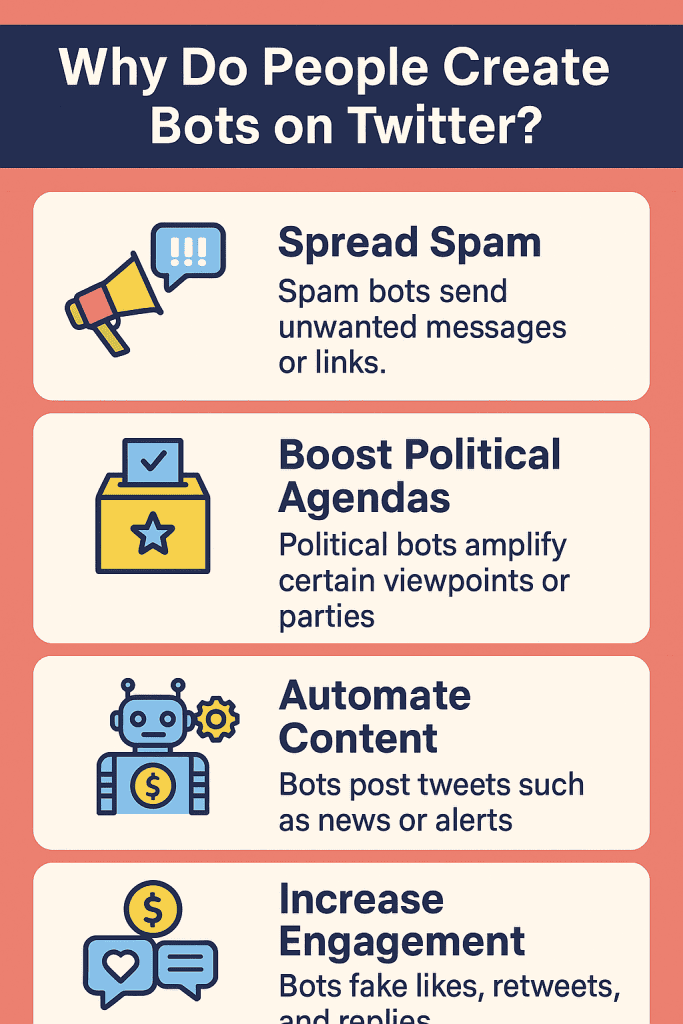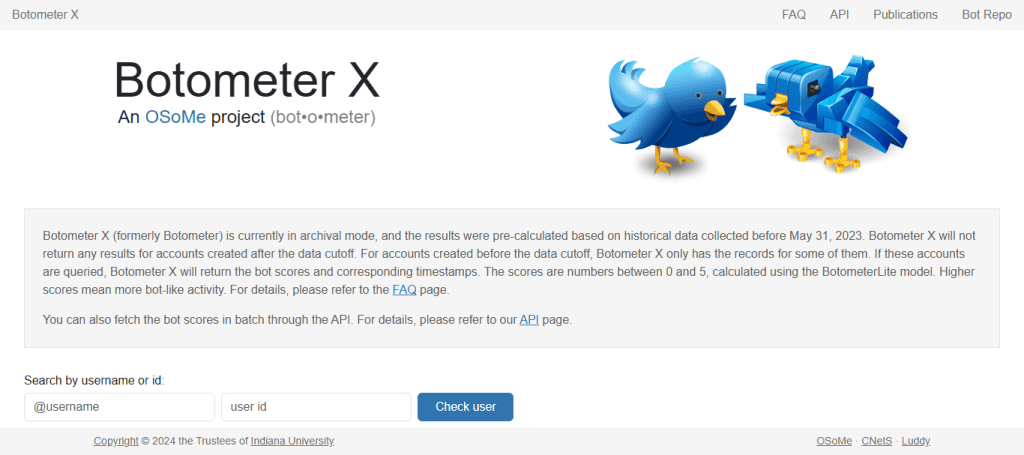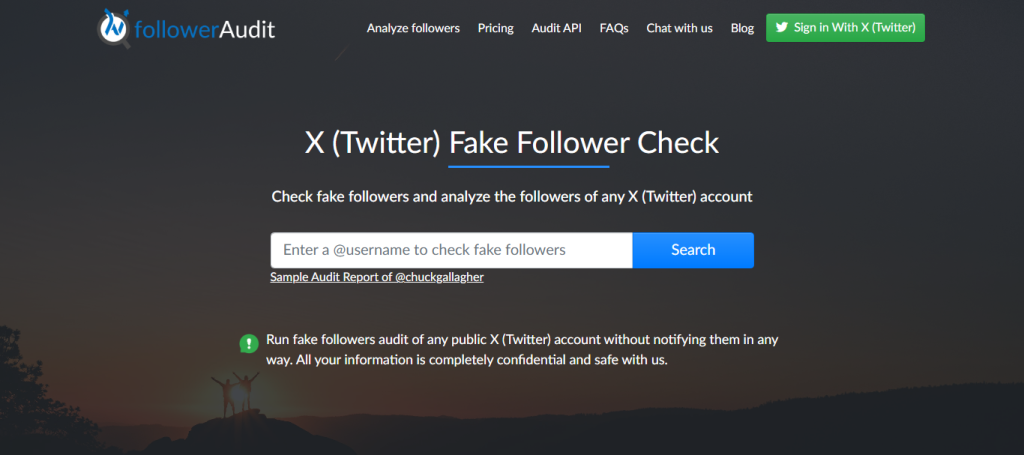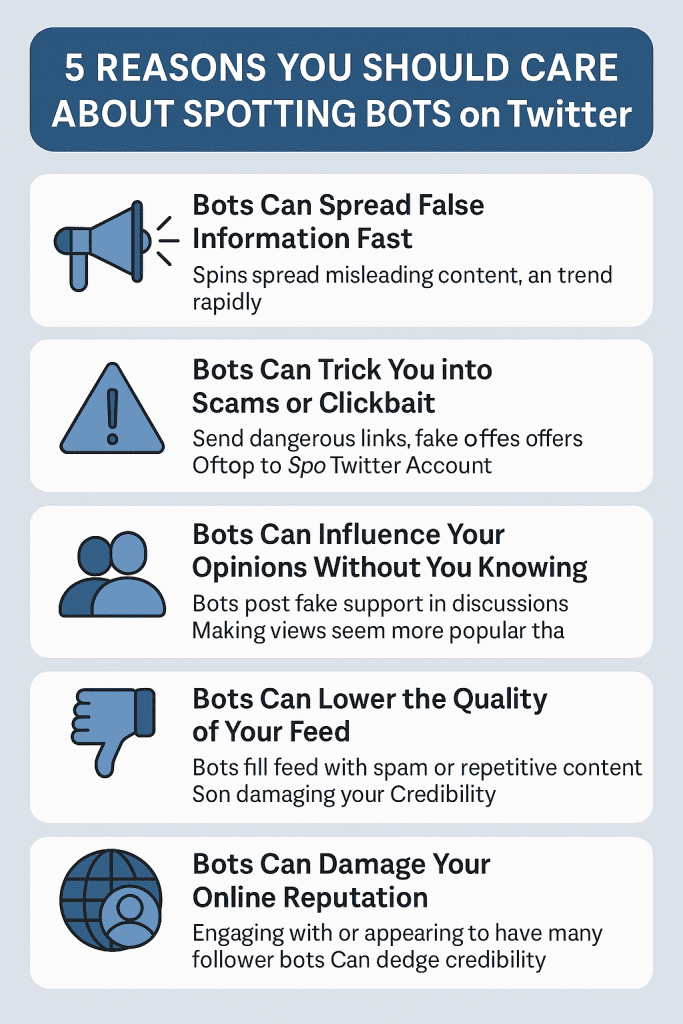As of 2024, Twitter has more than 500 million monthly active users. This makes it one of the most popular social media platforms available today. However, not all that half a billion users are real humans. Over the years, thousands of bots have flooded Twitter, pretending to be real users. These fake accounts have the capacity for both good and evil.
The dark side of Twitter bots is that they can spread false information, promote scams, boost fake trends, or even try to influence public opinion. Some bots are easy to spot, but others are cleverly designed to look and act like real people.
That’s why it’s so important to learn how to spot a bot on Twitter. Being able to tell the difference between a genuine profile and a fake one can help protect your account, keep your feed trustworthy, and stop the spread of harmful content. In this guide, we’ll show you the most common signs to watch out for to help you spot fake profiles on Twitter with confidence.
What is a Twitter bot?
A Twitter bot is an account that’s controlled by software, not a real person. These bots are programmed to automatically perform actions on Twitter like tweeting, retweeting, liking posts, or following other accounts without human involvement. Some bots are helpful, but many are used for the wrong reasons.

There are different types of Twitter bots created for different purposes. Some bots are made for good reasons, like sharing useful updates. But many are made to deceive, manipulate conversations, boost engagement stats, or carry out scams.
Some bots are specifically created to spam real accounts by sending out unwanted messages, links, or promotions. Others are politically motivated either to spread false information, help boost a person’s credibility, spread certain political messages or support specific agendas.
How to spot a bot account on Twitter
Twitter is full of real conversations but not every tweet represents the opinion of a real user.
Bots can spread spam, scams, or even false information while pretending to be human. In order to spot a bot on Twitter, look out for these simple, proven signs:
1. Check for a bot label on the profile
Twitter allows bot creators to label their accounts with a robot icon and an “automated” tag beneath the profile name. These labels are usually used by bots connected to Twitter’s API or bot programs and are meant to promote transparency. If you see this label, the account is likely part of a recognized automation process and can often be trusted especially if it shares helpful content like news updates or weather alerts.
However, not all bots carry this label, especially those with harmful or spammy intentions. Some bot creators choose not to label their accounts, and in those cases, Twitter may eventually flag or suspend them. When in doubt, use a Twitter bot detection tool or rely on other signs to spot a bot Twitter account more accurately.
2. Unusual or random usernames
One of the easiest ways to spot a bot Twitter account is by checking the username. Bots often use names filled with random numbers or letters (like @alex92748abc). These don’t look like real names. Real users usually pick usernames that reflect their identity or brand. If the handle seems messy or auto-generated, it’s likely a bot.
3. Generic or stolen profile photos
Many bots use stock images or photos stolen from other users. You can do a reverse image search on the profile photo using Google Images to see if it appears elsewhere. Real users usually have unique, personal images. If the picture looks too perfect or appears on many sites, you may have spotted a fake profile on Twitter.
4. Incomplete or suspicious bios
A blank bio or one filled with unrelated hashtags or buzzwords is a red flag. Bots often skip the bio section or write something generic like “love life, food, tech” with no context. If the bio doesn’t match the tweets or looks copied, it’s worth checking further. This is a classic sign when trying to spot fake profiles on Twitter.
5. High tweet frequency
Bots are very active, often posting tweets, replies, or retweets every few minutes, day and night. That’s not normal for real users. You can scroll through the account’s timeline to check timestamps. If it seems like they never stop tweeting, it’s likely that you have stumbled upon a bot on Twitter and it’s best to avoid engaging such an account.
6. Repetitive or irrelevant tweets
Bots often copy and paste the same tweet repeatedly or post random comments that don’t relate to the original post. Watch out for accounts that keep replying with similar messages or links. These accounts are designed to flood conversations, and recognizing them is key to Twitter bot detection.
7. Low engagement but high activity
If a user has thousands of tweets but very few likes, replies, or retweets, it could be a bot. Bots can tweet nonstop, but people usually ignore them. Real users get some level of engagement over time. A big gap between activity and interaction is a sign of a bot Twitter account.
8. Automated behavior patterns
Does the account retweet every 15 or 30 minutes like clockwork? Bots follow fixed schedules because they are programmed that way. They may also only interact with a certain hashtag or topic. If the behavior looks too predictable or robotic, consider using a Twitter bot detection tool to confirm your suspicion.
9. Engagement in coordinated campaigns
If you see multiple accounts tweeting the exact same message or replying with identical comments, it’s likely part of a bot network. These bots are used to amplify messages, promote spam, or fake support. Spotting these patterns helps you avoid being misled and lets you spot a bot on Twitter more effectively.
How to spot Twitter bots using bot detector tools
If you’re unsure whether an account is real, several tools can help you with Twitter bot detection. These platforms analyze behavior patterns, follower data, and tweet activity to help you spot fake profiles on Twitter quickly and easily.
Using these tools along with your own judgment can help you better understand account behavior and make smarter decisions about who to trust or follow.
1. Botometer

Botometer is one of the most popular tools for identifying bots. Just enter a Twitter handle, and it analyzes the account’s activity, language, and interactions to give it a “bot score” from 0 to 5. A higher score means the account is more likely to be a bot. Look for patterns like high tweet frequency, lack of original content, or odd retweet behavior.
2. Circleboom

Circleboom is a comprehensive Twitter management platform that offers features for identifying inactive, fake, or bot accounts. Its “Fake/Spam Account Checker” helps you:
- Analyze your followers for unusual activity patterns
- Spot suspicious profiles based on tweet behavior, bio content, and follower-to-following ratio
- Clean up your account by unfollowing or blocking detected bots
Circleboom also provides engagement insights, helping you understand which followers are actually interacting with your content.
3. FollowerAudit

FollowerAudit is designed specifically for Twitter bot detection. It audits Twitter accounts to determine what percentage of their followers are fake, inactive, or bots. Key features include:
- In-depth reports on your follower quality
- Detection of purchased or low-engagement followers
- Real-time monitoring of new followers to alert you to suspicious activity
This tool is ideal for influencers, brands, or agencies that want to maintain a healthy and credible follower base.
How to stop Twitter bots from following you
If your Twitter follower count is growing, but a large portion comes from suspicious or bot accounts, that’s a red flag. These bots may seem harmless at first, but over time, they can cause real problems, such as:
- A noticeable drop in engagement despite high follower numbers which can lower your reach and visibility.
- Spammy messages and suspicious links that may lead to harmful websites trying to steal your personal or financial data.
- Nonsensical or irrelevant comments under your tweets, which may confuse real followers or dilute your content.
- Damaged credibility as users begin to question the authenticity of your follower base.
- Poor results from Twitter polls or feedback campaigns, especially if you rely on accurate responses for decisions.
- No real value for business accounts as bots don’t subscribe, buy products, or engage meaningfully.
If you’re facing any of these issues, here are three practical ways to prevent bots from following you:
1. Enable “Protect Your Posts”
By default, your Twitter profile is public, allowing anyone including bots to follow you. You can change that by using the Twitter settings, Protect Your Posts (formerly Protect Your Tweets), to make your profile private.
This will make your posts private, which means users must send you a follow request before gaining access. Here’s how to enable this setting:
- Open the navigation menu on Twitter/X.
- On desktop: it’s on the left.
- On mobile: swipe left to right to access it.
- Go to Settings & Support.
- If you’re on desktop, click More to find it.
- Select Settings and Privacy and then click on Privacy and Safety.
- Under Your X Activity, click Audience and Tagging.
- Enable Protect Your Posts.
Once enabled, you can manually review follow requests to ensure no suspicious or bot accounts are following you or interacting with your content.
2. Identify and block bot accounts already following you
While making your profile private helps with future followers, it doesn’t remove the bots already following you. To clean up your current followers, you must know how to identify a bot on Twitter. Many of the signs to look out for has been discussed above but here are some to guide you:
- Random usernames filled with numbers or gibberish.
- Extremely high following counts but very few followers.
- Sparse or spam-heavy profiles, often with just one or two posts.
- Repetitive posting behavior or a feed full of retweets on a single topic.
Because real users can sometimes behave similarly, manual checking can be tricky. You can also use Twitter bot detection tools to help confirm your suspicion. These tools help you analyze your follower list and spot fake profiles on Twitter more efficiently.
How to Block a Bot:
- Visit the bot’s profile.
- Click the three-dot menu.
- Select Block and confirm your choice.
This removes the bot from your followers and prevents it from re-following you unless unblocked.
3. Report the bot to Twitter (X)
Blocking removes the bot from your feed, but reporting can lead to further action from the platform, like suspending or restricting the account. Here’s how to report a suspected bot:
- Go to the profile and click the three-dot menu.
- Choose Report and follow the prompts.
- Select the most appropriate reason such as, spam, using misleading hashtags, or posting harmful links.
- After reporting, Twitter will ask if you want to mute or block the user; select Block to finish the process.
Reporting helps Twitter/X improve its detection systems and protect the wider community.
Can Twitter bots ever be useful?
Yes, not all bots are bad as some can actually improve your Twitter experience. Useful Twitter bots are often designed to share helpful, automated content like news headlines, weather alerts, sports updates, or public service announcements. These bots save time by delivering relevant information directly to your feed.

It’s usually okay to follow a bot account if it’s clearly labeled as automated, shares consistent and trustworthy updates, and doesn’t spam your timeline. Many of these bots are transparent about their purpose and don’t try to act like real users. So, as long as you’re aware it’s a bot and it adds value to your feed, there’s no harm in engaging with it.
FAQ
How do I know if someone is a bot on Twitter?
Look for signs like random usernames, generic profile photos, repetitive tweets, and little to no engagement. Bots often post at regular intervals and follow many users without getting followed back. You can also use a Twitter bot detection tool like Botometer to check for suspicious behavior.
Can bots like or retweet my posts?
Yes, bots can like, retweet, and even comment on your posts. These actions are automated to boost certain messages or make accounts look active. If you notice sudden engagement from unknown or odd-looking profiles, it’s a good idea to investigate further.
Are bots illegal on Twitter?
Bots themselves aren’t illegal, but Twitter has strict rules against malicious or deceptive use. Bots that spam, mislead users, or impersonate real people can be banned. Legitimate bots must follow Twitter’s API guidelines and should be labeled as automated.
How common are bots on Twitter?
Bots still make up a noticeable portion of Twitter’s user base. While Twitter has improved bot detection, bad actors continue to create fake automated profiles for spam, scams, and misinformation. That’s why it remains important to spot bots on Twitter and use trusted tools to filter your feed.
Wrapping up
Bots are everywhere on Twitter and while some are harmless, many are designed to mislead, spam, or scam users. By now, you know the key signs to spot a bot on Twitter: unusual usernames, generic profile pictures, incomplete bios, high tweet frequency, and low engagement.
You can also use tools like Botometer and Circleboom to help confirm your suspicions. If something feels off, trust your instincts and dig a little deeper. Knowing how to spot a bot on Twitter not only protects you but helps keep the platform safer for everyone.








